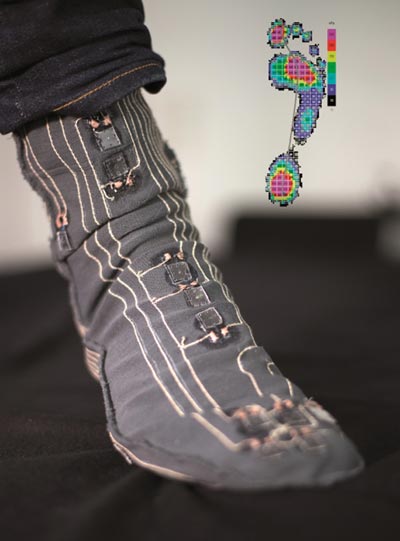Fraunhofer ISC enables wearable technology for medical devices

Elastic sensors for textile integration e.g. for three-dimensional pressure readings for diabetics. Source: K. Selsam-Geißler, Fraunhofer ISC
Elastic sensors integrated in textiles
A new class of mechanical sensors is especially suitable for integration into woven or knitted fabrics because of their high elasticity and their soft and flexible characteristics. These dielectric elastomer sensors (DES) can be integrated into the textile by bonding or sewing, and can be used to measure deformations, forces and pressures.
Very high strains up to 100 % and more can be achieved. DES consists of a very elastic elastomer film coated with highly flexible electrodes on both sides. By patterning the electrodes on the elastomer film an array of many elements can be built up.
The textile-integrated sensors are washable, show a high wearing comfort and are reasonable in price. Silicone rubber is the preferred basic material for the elastomer film and through chemical cross-linking offers a broad variability of hardness. As a result, the material can be adapted to the specific requirements of the sensor.
Versatile applications for medical and training purposes
The textile-integrated elastomer sensors are applicable in medical devices e.g. for preventing bedsores or for localizing the pressure distribution in shoes. They can also support personal training by measuring the posture via the clothes or as an input device for game and fitness device controlling.
The textile form is very variable – if it’s a stocking, glove or shirt – as the sensors are stretchable and easy to process. Beyond that DES improve industrial safety, e.g. of human-machine interfaces in collision detection systems.
Three-dimensional pressure readings for diabetics
At the IDTechEx, Fraunhofer ISC shows a novel kind of pressure stocking developed together with Fraunhofer IIS: It protects diabetics against wounding via an integrated sensor system that sends a warning signal when pressure in the shoe is locally too high. As diabetics often have little feeling in their feet they don’t perceive pressure or temperature signals.
This can result in unnoticed wounds that then may develop into abscesses. Therefore, many diabetics have to have toes or feet amputated. In total, 40 very fine, dielectric elastomer sensors measure compression load and distribution in the stocking. They are attached to the stocking’s sole, the heel, the top and the ankle, in order to achieve a three-dimensional reading. Existing systems measure the pressure distribution only on the bottom of the foot using shoe inserts.
If a patient stands in one spot for an extended period, pressure will rise. The sensors recognize this rise and transmit the measurement signal via a conductive thread to a low cost wireless electronic unit. The application-specific integrated circuit (ASIC) chip collects the measurement data from 40 capacitive sensors and the controller transmits the data wirelessly to a smartphone or tablet e.g. to advise the diabetes patient to change foot position or weight distribution.
Fraunhofer ISC has submitted this project for an IDTechEx Award 2015.
Flexible, light and thin – further developments
Apart from the textile-integrated sensors, Fraunhofer ISC presents its expertise in printed electronics, 3D printing, thin film batteries, and multifunctional barrier coatings for flexible films.
Attendees can meet the experts of Fraunhofer ISC at booth P21 at the IDTechEX, Santa Clara (USA).
http://www.isc.fraunhofer.de
https://www.youtube.com/watch?v=0P8FEeoG7mY
Media Contact
All latest news from the category: Medical Engineering
The development of medical equipment, products and technical procedures is characterized by high research and development costs in a variety of fields related to the study of human medicine.
innovations-report provides informative and stimulating reports and articles on topics ranging from imaging processes, cell and tissue techniques, optical techniques, implants, orthopedic aids, clinical and medical office equipment, dialysis systems and x-ray/radiation monitoring devices to endoscopy, ultrasound, surgical techniques, and dental materials.
Newest articles

Time to Leave Home? Revealed Insights into Brood Care of Cichlids
Shell-dwelling cichlids take intense care of their offspring, which they raise in abandoned snail shells. A team at the Max Planck Institute for Biological Intelligence used 3D-printed snail shells to…

Smart Fabrics: Innovative Comfortable Wearable Tech
Researchers have demonstrated new wearable technologies that both generate electricity from human movement and improve the comfort of the technology for the people wearing them. The work stems from an…

Going Steady—Study Reveals North Atlantic’s Gulf Stream Remains Robust
A study by the University of Bern and the Woods Hole Oceanographic Institution in the USA concludes that the ocean circulation in the North Atlantic, which includes the Gulf Stream,…



